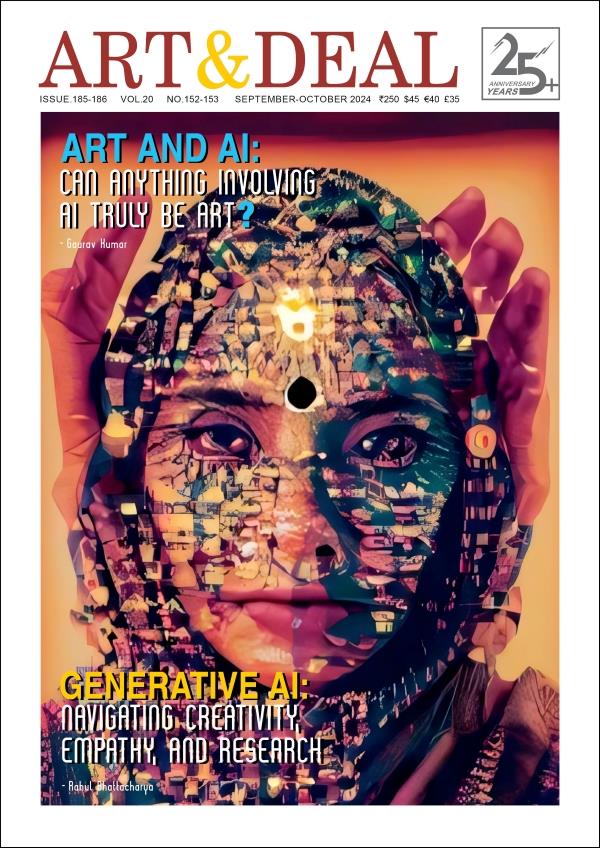Noor Riyadh, November 2023 Harper’s Bazaar Saudi Jerome Sans, Infrastructure of Light by Rajesh Punj

Jérôme Sans, Alaa Tarabzouni, Fahad
Bin Naif,
Photo © Ammar Abd Rabbo
French sociologist and philosopher Jean Baudrillard coined the phrase ‘everything will become infrastructure bathed in artificial light and energy’, which offers so much to explain the ambitions of Noor Riyadh, Saudi Arabia’s festival of light. In a country, a capital, characterised by the warmth of the daylight and the desert, it is a city transformed by the bravura of the night, when the artificial and the ‘man-made’ come to life. A greater that is a distraction from the stars, and that artificiality, of living whilst the light sleeps, is something that literally critic and scholar David Daiches saw as a greater opportunity for ‘man’s exploration of man by artificial light, which is better than natural light because it can be directed as we want it’. Replacing literature with light art, lead curator Jérôme Sans, sees the latest edition of Noor Riyadh’s, as the darkness craving the light, and for this year’s festival, the night is positively nourished by incarnations of artworks igniting the skies the length and breadth of Riyadh, like fireworks celebrating the passing of the daylight for the night.
Entitled The Bright Side of the Desert Moon, Sans’ Riyadh festival draws on one hundred and twenty works from a choice of national and international artists; as beacons of light equal for everyone in a city that never sleeps. Noor Riyadh is emblematic of a country and a region that is thriving on a new openness in the outside world, and as a language light is universal. Manifest as a light show of fluid and far-reaching works, that Sans explains as resituated and newly commissioned. The third edition of the festival sees no space or place as undeserving of the endeavour of any of their artists. Like neon signs blinking, many of the works do little more than overwhelm you, until the sincere sophistication of Lachlan Turzcan’s Wave Space 2023, in close proximity to Conrad Shawcross’ Slow Arc Inside A Cube XI 2023, and Julian Charrière’s Vertigo 2023, cast a shadow over the kitsch. Aidha Badr’s Please Don’t Leave Me Yet, We Know So Little About Each Other 2023, is a work that appears meant for Instagram, and The Ancient Ones 2023, by Ayman Zedani, is deserving of so much of our time, for his reintroducing nature to wherever we are in the city. With a work that concentrates, unflinchingly, on what we ignore entirely of the ecosystems that emerge from, and are not made on the earth. Works presented as part of the aptly titled Refracted Identities Shared Futures, of artists born and based in different countries and regions, arriving or leaving to return.
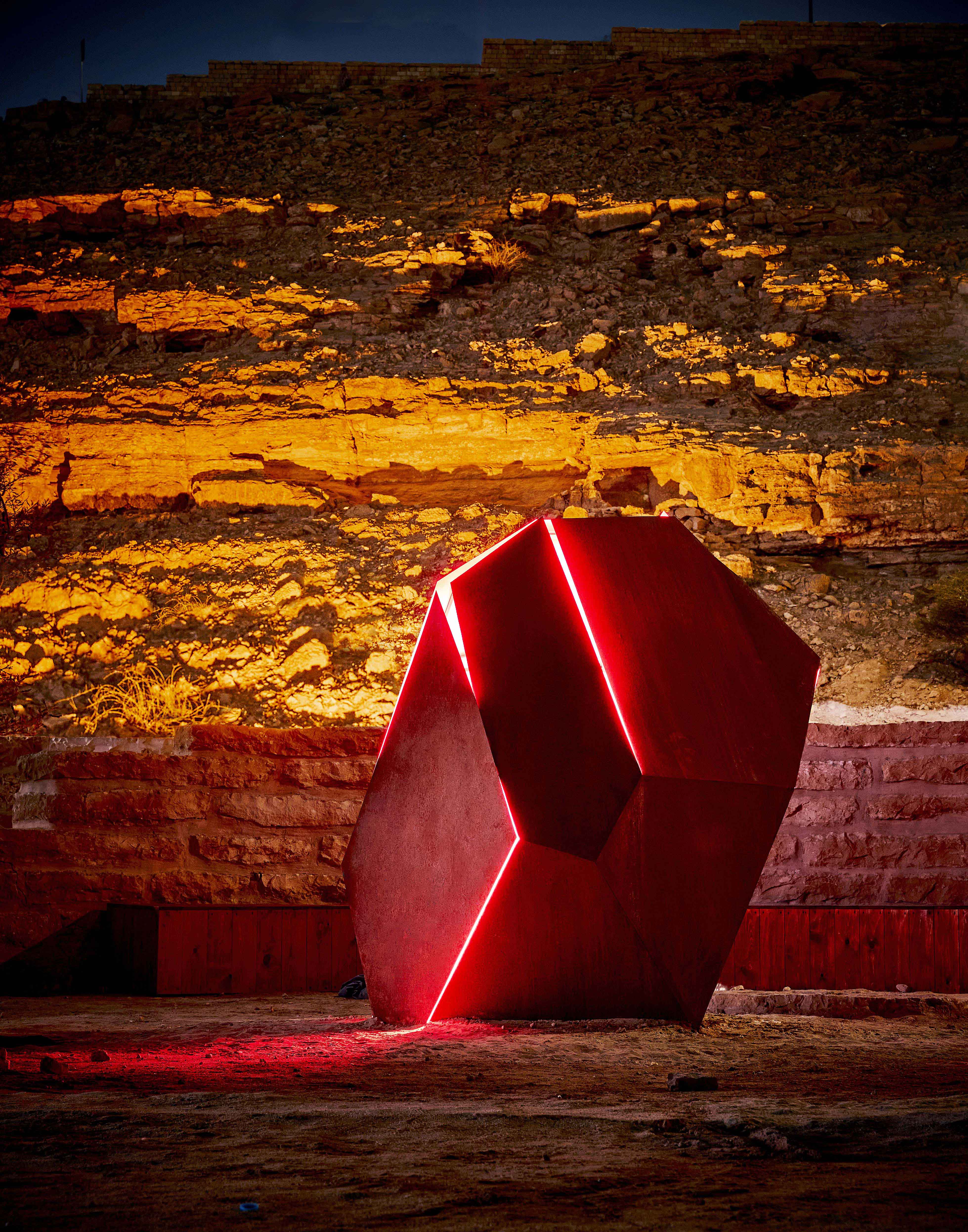
Image courtesy: the artist and HAVAS, Photo © Noor Riyadh
2023, a Riyadh Art Program
Shilpa Gupta’s site-specific We Change Each Other 2023, which sits at the water’s edge, alters as you look at it; its language changes from sensible to strange. In the JAX district Muhannad Shono’s Absent Sky 2023, follows on from the motives and motion of his Venice Biennale Teaching Tree 2022, as his fabric sky undulates as though about to open up to the heavens. Located in Wadi Hanifah Random International’s Living Room 2023, is far from inhabitable, as beams of light that are centimetres apart, run from ceiling to floor in an otherwise entirely darkened space; a work in which the light becomes one’s salvation as much as suffering. Likely a thousand in number, the threads of light appearing almost permanent, are interrupted only by the introduction of a new audience, who for a moment experience a heady mix of confusion and claustrophobia, matched by a sense of elation.
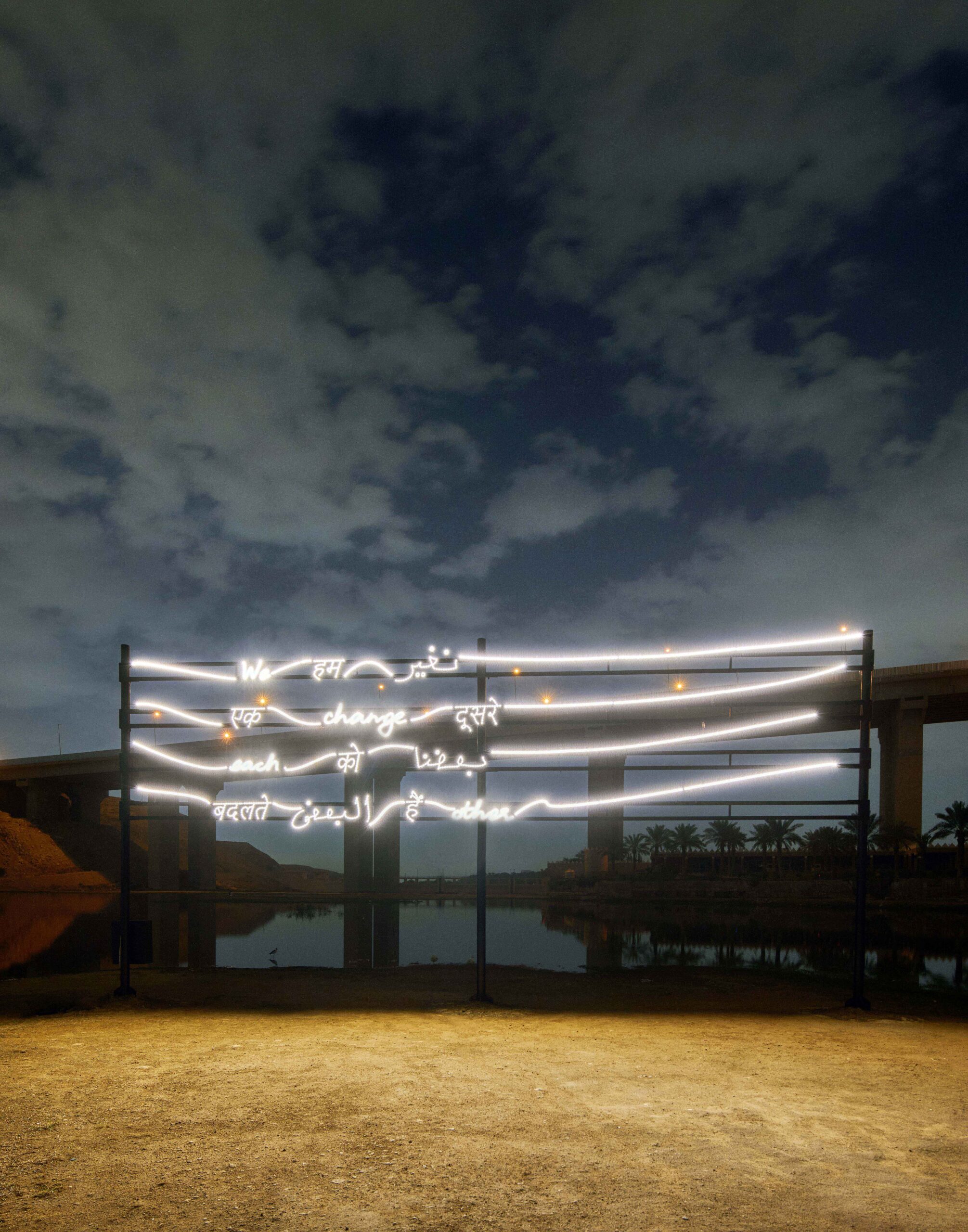
the artist and HAVAS, Photo © Noor Riyadh 2023, a Riyadh Art
Program
The location of works takes on a greater significance with the coloured cliff faces of Angelika Markul’s Zone Iguazu 2023, as much as Diana Thater’s A Wild Kingdom 2023; projections that are applied to the rock-like fossilised fables, which in the traditions of Saudi culture, are intended to be passed on from person to person. The more alien artworks are Lúcia Koch’s Picnic Cones 2023, Abdullah Alamoudi’s Look Up and You’ll Find Me 2023, Jose Dávila’s Luminous Whispers 2023, Thurayya by Madhawi AlGwaiz 2023, that all bleed light as though we are in the presence of the other, and Claudia Comte’s Monument to the Disappearing Forest 2023; a haunting work that rises from the dirt as a grid of faceless totem poles encrusted with LED lights. Placed among these virtuoso works are cinematic screens radiating moving images of lost landscapes that are deserving of the unusual setting they have been given.
As of the previous two editions, what might appear as a burden upon the city’s already overstretched infrastructure, is adopted with as much glee as the individuals ready and able to explain works that have them standing alone in near darkness, waiting for their audience. The cooperative energy that supports this major event is equal to anything offered as art. Reflecting on a country believing in its augmented transformation, and being witness to that is something to behold.
Interview
Rajesh Punj: Thank you for your time. It is an incredible privilege to be able to speak to you about this year’s Noor Riyadh, and more broadly to discuss a lifetime of innovative and ambitious projects. To begin with, it would be interesting to talk about your philosophy for curating, and of the coming together of art under the ‘Noor Riyadh’ umbrella.
Jérôme Sans: A wonderful question and place to begin, well the way I approach a project is first within a chosen context. Each of the works is intended as site-specific, special and specific to a location. For example, we are in Riyadh, Saudi Arabia, and I was fascinated when I came here. Firstly the intensity of the light is very bright, very different from what I experienced anywhere else in the world – Los Angeles, in Asia wherever. So I was touched, devising ways of utilising the light that was quite overwhelming, that dissipates over the landscape and in the desert. For me the desert was a metaphor for the world we are living in, meaning that this light is dissolving my difference with you, of wider differences between communities and societies. Essentially we are all together, and the time we are living in is such a complex one. What I wanted to concentrate on here in Riyadh is this idea that a desert is what we experience in the contemporary world, with us progressively not noticing it. The fact that our megacities operate as these fantastic machines, makes us live and experience everything at an incredible rate, minute by minute, and at the same time, we are going backwards in our human relationships, to zero. I was fascinated, as I said, when I came here for the first time, when we were walking down to the river, close to the desert. Where you have families, friends, and colleagues, all come at night to have dinner, sitting on these outstretched carpets, making barbecues outside, next to each other very peacefully. And when we walked among these people, with them having dinner together with their children running around the food. I was surprised that people were ready to stand and connect with me, proposing coffee and a date; of bringing me a piece of cake, whilst welcoming me to Saudi Arabia.
As someone new to the country, I initially didn’t understand what was happening, and I looked at it as a person from the other side of the world would, asking myself why I was deserving of that. When in fact I was looking at it with the wrong attitude, and in that moment I was able to recall when I was younger, in the village where I was going to with my parents, everyone easily and very openly welcomed one another. Yes, we were opening our arms, and offering each other things in the same way.
From where we are, with our continuing to expand our knowledge and use of technologies, we are inversely closing ourselves off from everyone else, which is reflective of our digital world. Given social media, I am connected to you, because it is a world in which I can pretend to be incredibly popular, but then you can be even more, with 100,000 followers; and superstars. Everybody knows you but you are the most alone, even though you have thousands ‘liking’ everything you do, and that comes back to where we are now, to the desert, where you are less and less connected to reality. Here I found that human connections still exist, and that looking at the other is not something alien or uncomfortable, but positively beautiful; and I’m not naive. I have experienced that everyone is welcome in Saudi Arabia. I have never had that experience in Paris facing different nationalities, so it was a moment to question everything about myself; and where I live. Coming from a city we initially see everything differently, with a deliberate distance. For me the desert isn’t just what we see beyond the city in Saudi Arabia, it exists in all of its manifestations across all of the cities around the world, mega desert cities, and at the same time we living through an ecological crisis, where flooding is an issue that we share all over the world. We are all becoming, as I said, a desert. It is not just a beautiful idea; wherever we come from we face the extremes of a social desert and physical flooding.
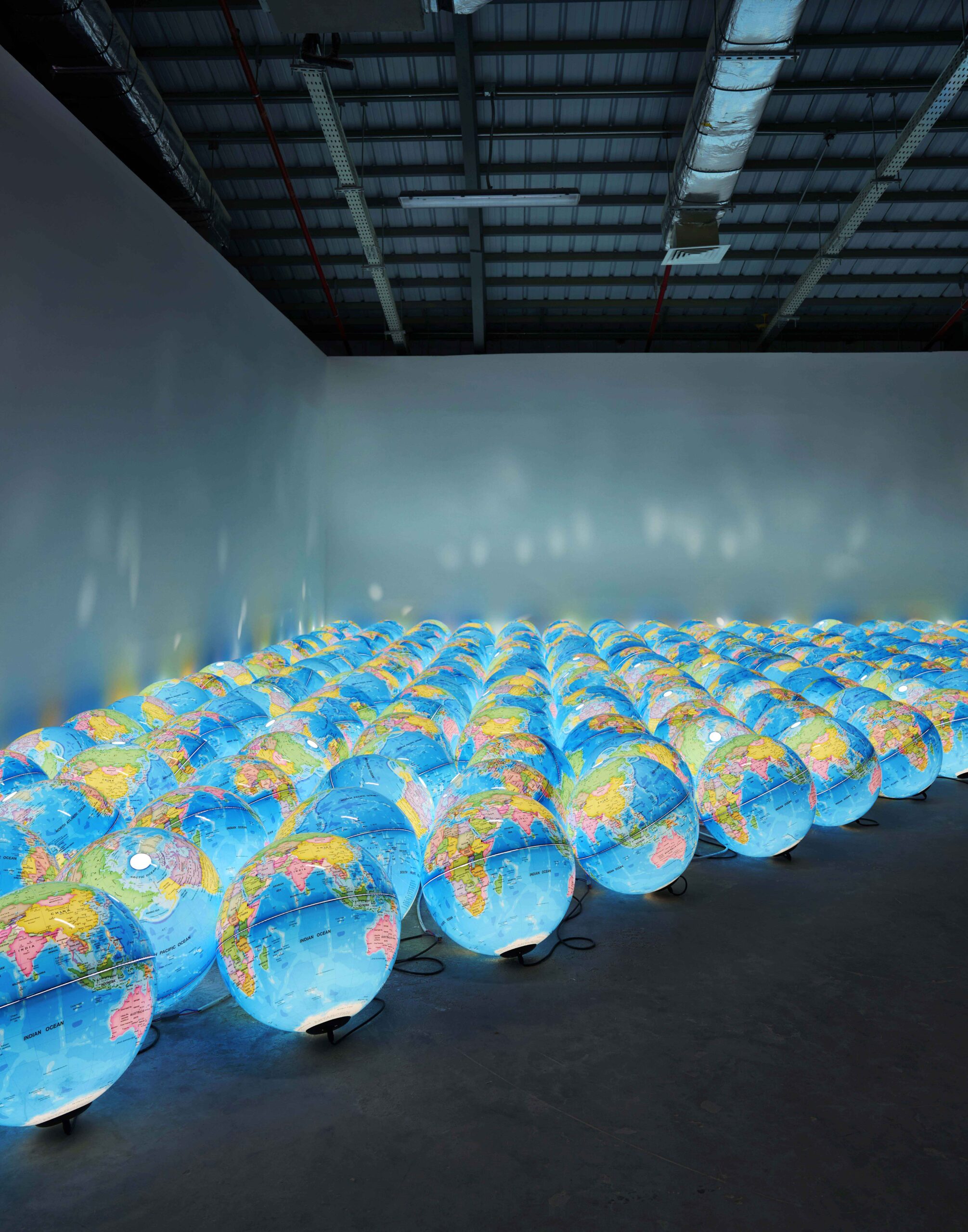
Image courtesy: the artist and HAVAS, Photo © Noor Riyadh
2023, a Riyadh Art Program
RP: The desert becomes as much metaphorical, as you insist, as it is experiential, and that analogy becomes interesting when you apply the emptiness to the ‘desert’ or disconnectedness of our modern lives. Does that overlap, of one world with another, in any way complicate, what is fundamentally a natural phenomenon?
JS: The Bright Side of the Desert Moon is about that. What can we do without the author? The moon is a circle, and the sky is something we all share, with us running in one direction. Yet we don’t want to go together, considering the other. Two years after the Covid pandemic was brought under control, two years after everybody else was looking for a ‘return to normal’, I remember thinking it was the moment to consider where we all come from. We all come from the village, and not from the megacities, even if we were born in the city, we come from another world. So human scale is a fundamental part of everything, when we should consider the other, the newcomer, and always provide a place for everyone at the table. We don’t have to look too far to see that today we are fighting against one another for stupidities. For me, this exhibition was an ode to slow down. Being here is far removed from our certainties and our knowledge of what we are familiar with.
We think we know everything, and that we are living in the best age, and in the best way, and we say to the world, that ‘this is the only way’; but to learn something from someone else, to listen to someone else, has us slow down, and reconsider our lives and their direction. Which has us ask, why do we do as we do? And is it that I do everything for myself, without another? To introduce these ideas is to acknowledge that there are other people, whose work and approach suggest we can do something together; that maybe we can do something better for the other; so the ethos is about a ‘togetherness’ of people. For me, coming back to your question, the way of approaching a new environment is by diving in and asking and understanding where am I, and who am I with, and not just imposing something from the outside. I have done it in Mumbai or New York, and I can bring the same model to Riyadh, isn’t going to work, and it makes no sense to work like that. Firstly it is about having respect for where you are, and to forget for a moment where you come from, to be able to learn about where you are.
I was interested in this being a popular project, and I have nothing against popular things, on the contrary, I’m very happy to be part of, and contribute to, popular exhibitions. When it happens in the art world I don’t consider it as something bad, I try to be open to the world and to what is possible. I find it fascinating that you can propose things that they, the audience, will never have seen before. So close to them, in situ, that they can touch the works and understand things from them. I wish when I was a child I had had the chance to discover art in this way. When I was younger I was just going to museums, and for that, you have to make the effort to go to a specific place, pay for your entry and go inside. For me, I have always believed in the notion of art for all, not just for a little circle of experts. It’s good to have each other.
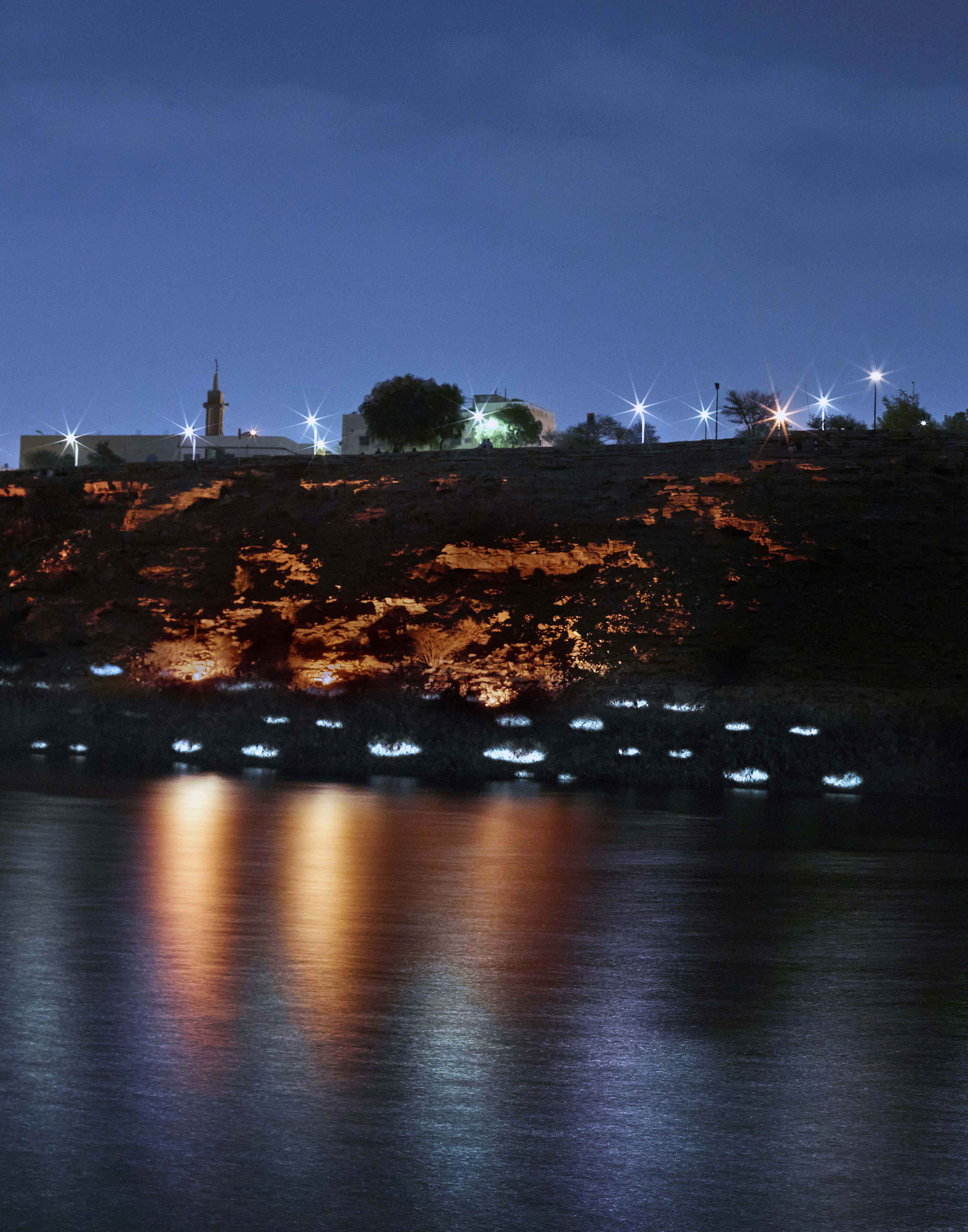
the artist and HAVAS, Photo © Noor Riyadh 2023, a Riyadh Art
Program
RP: It’s interesting because I wrote recently about the notion of art becoming more experiential, specifically here in the Middle East, in opposition to the more traditional idea of the static painting or the sculpture, just as you talk about the tradition of a specific space or place for art, where you have to buy a ticket, so it becomes something else, where we are not all necessarily privileged to have access to art.
JS: I’m happy to be privileged, but it’s something I always want to share. There is this fear of no one feeling special, a VIP, but everybody’s a VIP. So when Nicolas (Bourriaud) and I co-founded Palais de Tokyo, we intended to create a place, a platform, for art with an open dialogue, for everyone, and that philosophy for all was something we wanted to recreate herein, Riyadh.
RP: Something that has interested me for some time is the idea of space and scale. How have you managed them when you come to a country that is so vast, and where space is beyond measure?
JS: Everything can be big and small at the same time, small in the sense that it’s not about creating a spectacle for me. We want this to be a human experience, where the viewer comes by himself, or as an audience with a friend and family. So it is entirely about projects that fit the scale of a location. If the works are very big, it is because the scale of the place determines them, and the artworks have to work in harmony with the environment they are in. So we were really working towards creating a partition, a musical partition, where each work in its location has its own space, and that even though they are all individual, together can create their symphony, which unfolds during the night and exists for a time overnight. An experience invented by the modern world. Everything is illuminated; there are no more shadows at night, so the world never stops. Leaving the city but not the body, we are resting at night and early in the morning.
RP: At the beginning of our conversation you talked about not wanting to impose your ideas or your personality upon where you are. How have you managed to do that? Something you talked about in the panel discussion yesterday, when you referred to your time in China, was your reaction to a completely different location, how you introduced yourself to where you were, and what you were being invited to do. How, here, have you added to the conversation, rather than it being your vision entirely?
JS: Because we had the chance here to work, to collaborate. We met with the curators here in Riyadh and learned a lot because if I were to come as myself, I would have projected clichés onto this country if you see what I mean. Through their eyes, their behaviour, their references and their knowledge, we learned a great deal about the country we were in, and with that support system, we were able to dive into the reality here. So they gave us the keys. Often when you travel you are without local insiders because I never want to be outside of a place, or alien to it, I want immediately to have a chance to be at the centre of a place, and here they gave us that kind of unique possibility almost immediately.
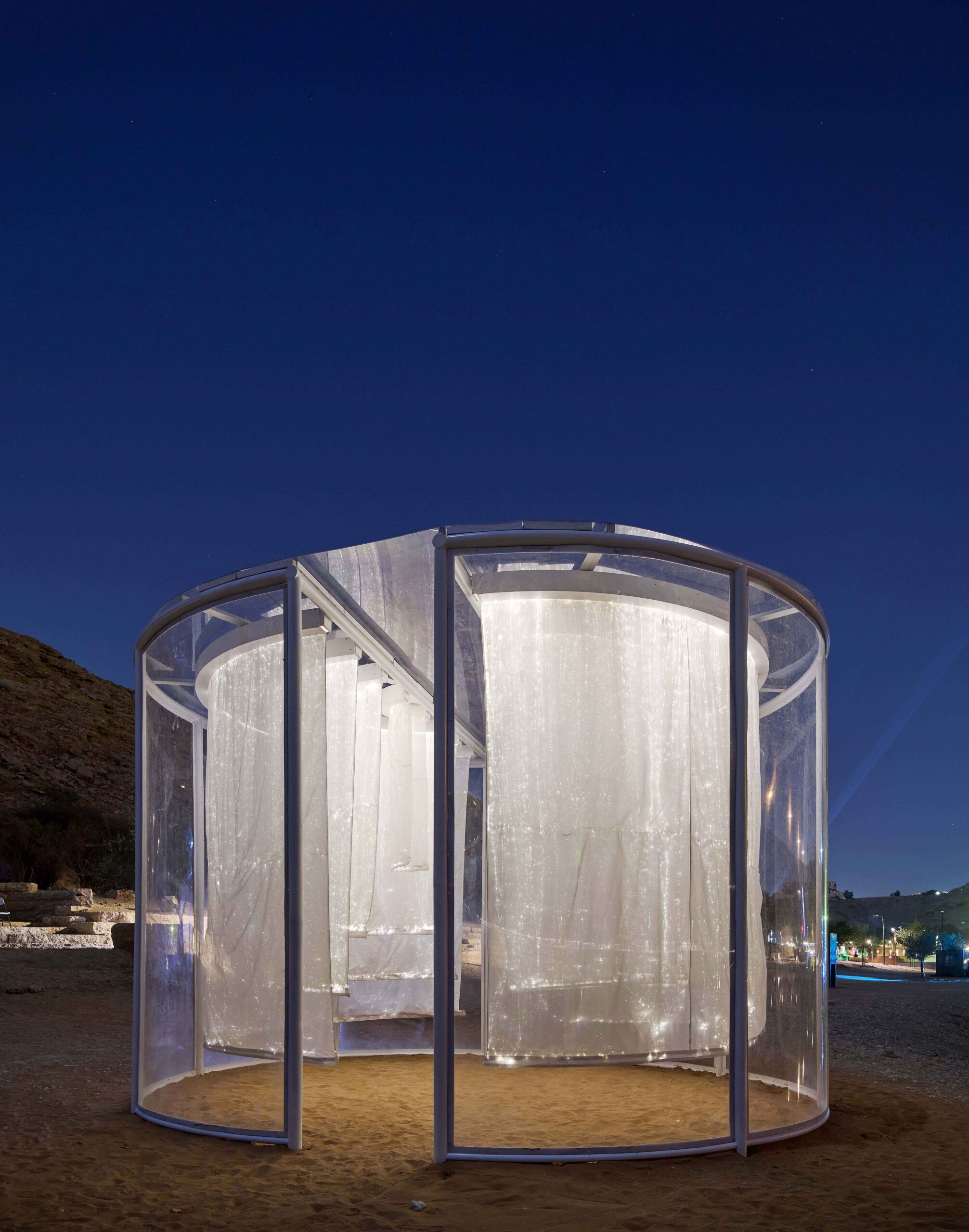
Image courtesy: the artist and HAVAS, Photo © Noor Riyadh
2023, a Riyadh Art Program
RP: That must come with a lot of confidence. Talking more widely about locations, because you have curated in so many different cities, do you ever feel overwhelmed by where you are? Or do you take the energy of that place and think I can do something here, something beautiful? When to talk as well about collaborating as a tool, and not acting as the individual, it has to be celebrated, the idea of not knowing I mean. It is a wonderful notion that allows for much more.
JS: I always want to go everywhere, because I feel like with every new experience I am reborn, and that things are never the same; that everything is changing. And this is for me a way to still feel alive, to still feel connected to the world I’m living in. Towards this unique chance as a human being to become globally wise, and each time to have such a unique experience in the world, and to share that with others. For me, the most exciting part is always about sharing experiences and ideas with other people, and reacting to things, as I would never think to do by myself. I love to learn through your eyes, and by your knowledge. We are always telling ourselves it’s too easy to repeat oneself, which gives the impression that you know everything, but constantly repeating oneself is to compromise. It is about putting yourself in places that challenge you, and I seek that all the time. Because it becomes too easy to think that you know everything from your small successes. Because it should be that you begin with, ‘I don’t know’. ‘I have no idea’.
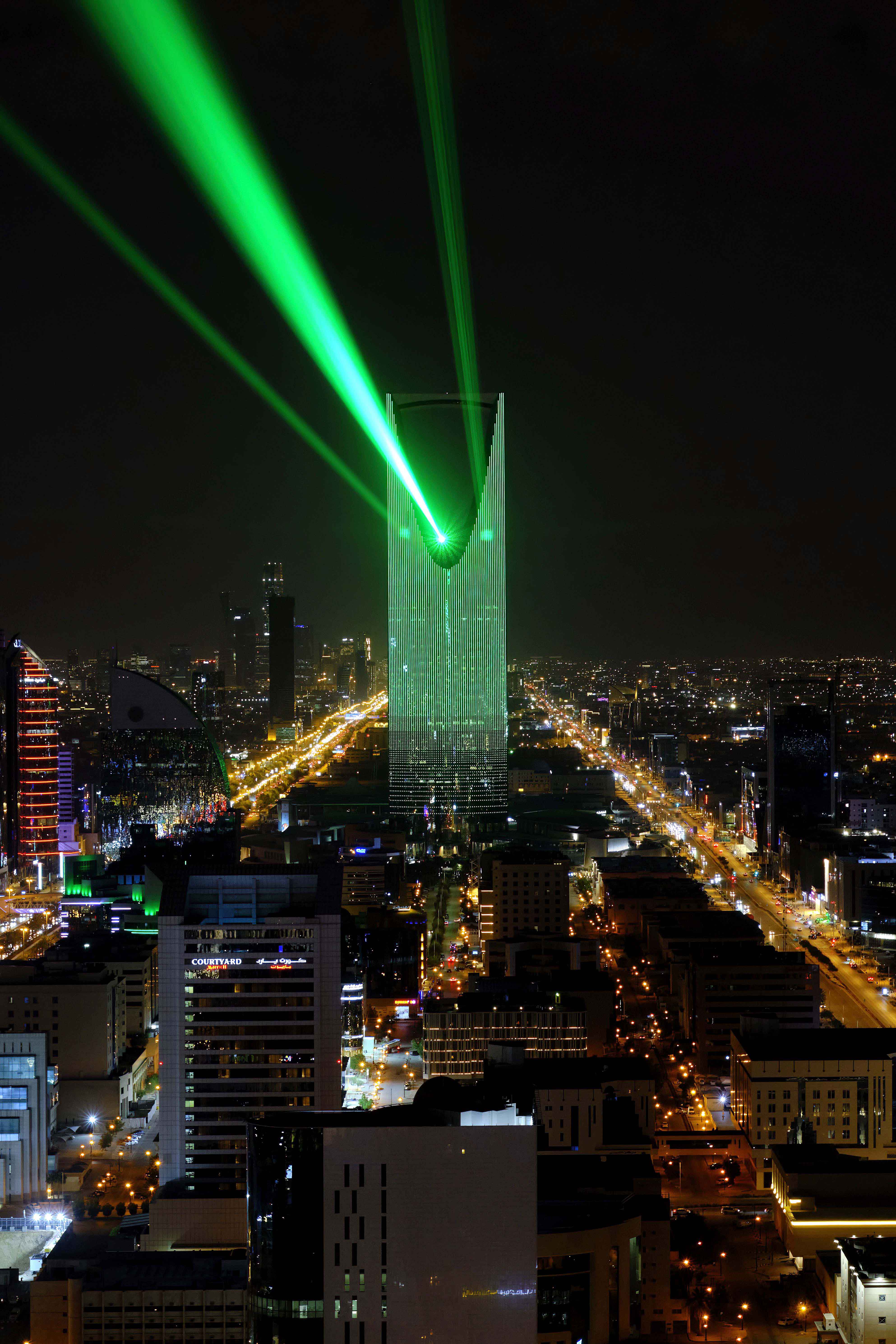
artist and Mario Guerra, Photo © Noor Riyadh 2023, a Riyadh
Art Program
RP: You begin from zero; it’s your ground zero.
JS: Every day I started from zero. As an independent curator, I come from a country where to be a curator you had to have a specific diploma, like a lawyer or doctor. The kind of bureaucratic system in which people think they are accomplished enough, and more connected to one another, not allowing anyone else in. I started like an orphan on the road, inventing my own words and using my own language, because I wasn’t allowed to be a curator, and so I went where I was able or create my own spaces, wherever I could in the world. I was given no opportunities to begin with, so I created and curated my own shows. They started in the UK, Canada, America and Japan; everywhere I could around the world, as I deciding what I wanted to do. Which was to invent something for myself that would fit in the world. We are all connected to the world in a new way, not as we were in the 1950s. So many designers are still applying that model to everything, still using a Nokia today from the early 2000s, no camera, no email facility, much the same as me. I am always interested in bringing things back and reconnecting them to the present. It can be hard to adapt oneself all the time, to the situation, to the context, always trying to break away from what went before. Looking at today, facing today, without turning your back on yesterday.
RP: That creates a really interesting analogy, because I think of how art historians and curators today ‘sit’ on knowledge, reprocessing it, time and time again, and it is seen as acceptable, but frustrating for the future of the arts.
JS: My interest is sound but simple.
RP: You talked at the beginning of our conversation about when you were meeting people in the desert for the first time. Some of the most incredible encounters we have in our lives can be with strangers.
JS: I wish you were with us when we were walking down, seeing these young children coming to us with a big smile, offering us something to eat and drink. For me it was more important for us than reading articles and books on the region, or whatever it might be, because it was bringing us together on a human level. What does it mean? To be honest, it is about family.
RP: I think in the centre of a city, Paris, in the middle of London or Antwerp, those connections are easily lost or can become very alien as you said.
JS: It is a global thing, and it is what makes it so beautiful coming here. It is about finding a way, a solution, and about constantly repositioning and reinventing oneself, to experience something different.
RP: And then in terms of the artists that were selected here in Saudi Arabia for Noor Riyadh, what kinds of decisions were you making, in terms of who you were choosing? And was that something that you and your colleagues were discussing for some time? And by that, I want to understand if you are constantly being made aware of new artists.
JS: Normally, when I work with artists I consider and act by a ‘long run’. I always want to work with artisans who want plenty.
RP: Interesting.
JS: I see it like a relationship with a friend. For me, art is about how to be with a new person, with whom you have the chance to permanently create a new chapter of your life. I never understood the idea of doing one show with an artist, and then never seeing that artist again, or never working with them again. I always want the possibility for more, always running for the chance to work once, twice, and possibly three times with the same artist. Why not? Each encounter is a new chapter. So here I wanted to invite many artists that I have worked with before. Everything is intended as very organic, encouraged by new contexts. But most of the artists I have worked with have come here.
RP: The strongest thing here is the involvement of light, natural and artificial.
JS: The day and night light is impressive, almost unbelievable at times.
RP: So you see the artist’s work from two different perspectives; in natural light appearing lesser, and more illuminated at night.
JS: Here everything is at night, and Noor Riyadh is to be experienced at night, mentally and physically, beyond the experiences you have during the day. The darkness allows for the works to come alive and offers so many different perspectives.
Read More>> Please Subscribe our Physical Magazine
